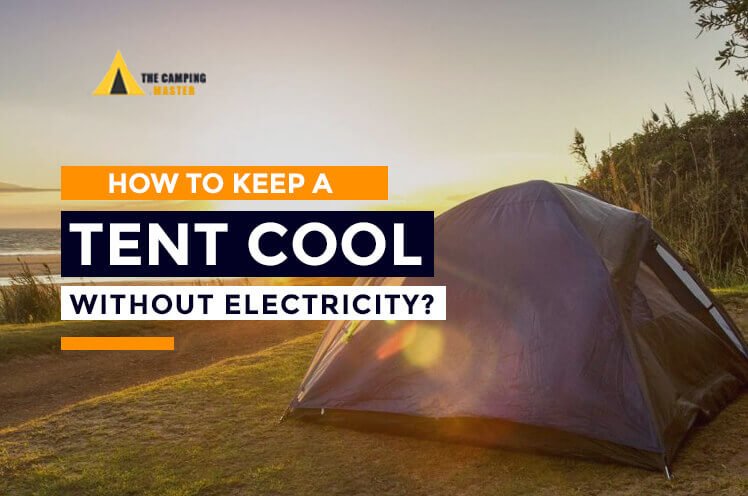This article will teach you how to cool a tent without electricity. Thankfully, there are numerous ways to cool your tent throughout the warmer months of the year, allowing you to sleep coolly and peacefully. If you want to cool your tent on a hot day without electricity, you can use this guide to help you determine what to do.
I’ll describe a few easy methods in this post to keep your tent cool without electricity. So, whether camping out in the woods or just going for a quick weekend getaway, use the below-given strategies to stay cool.
Even though tent camping in the summer can be a lot of fun, the heat can build up rapidly. You want to be as comfortable as possible when camping, especially in a tent. A heated tent can make it difficult to sleep at night and uncomfortable during the day.
In this article, I’ve put together a list of 16 camping tent cooling tips so you can have a great camping experience. Find out how to keep a tent cool without electricity.
What to Look for in a Tent’s Cooling Features
The following are the four things that you should look for in a tent colling feature. Here are some characteristics to consider:
- Buy a tent that is made of Mesh Material.
- Taller Tent (if there is space in the tent, you will not feel suffocation).
- Cotton or Canvas Material tents are also suitable for calling features.
- The tent has Zipper Screens.
How to Cool A Tent Without Electricity? 16 Best Methods
Following are the 16 Best Methods to cool the tent without electricity.
1. Utilize a Summer Tent
Use a tent designed for hot weather as it is the best advice for keeping a tent cool. These tents for camping are made to resist heat. However, that does not imply flimsy. The Kodiak Flex-Bow, for instance, features steel poles to enable it to stand tall against sweltering summer winds. It has doors on either side as well for better cross-ventilation.
2. Select the Correct Location
It would help to choose an area that receives as little direct sunlight as possible when looking for a suitable location to erect your tent. It would imply some form of shade that is not significantly impacted by the sun’s position. The majority of trees’ canopies serve as a great illustration of this.
You should consider and pay attention to where the sun will be at noon. Even while the light will still be bright at dawn and evening, it won’t be directly overhead your tent. If you have to choose a time of day to avoid the sun, try to avoid it in the middle or late afternoon when the sun is at its fiercest.
Some techniques for keeping your tent cool entail making up for the fact that you can’t avoid the sun. After all, most of these techniques overlap in some way.
3. Ensure that Your Tent has Good Ventilation
You can use adequate ventilation to cool a tent without electricity. It’s likely poorly ventilated if you’re having difficulties keeping your tent cool. Keep the windows and door open whenever possible to let fresh air in. Even on the hottest days, the breathable fabric will keep you cool and comfortable for as long as possible.
4. Use the Battery Operated Fan
Try utilizing a battery-powered fan to avoid fiddling with solar-powered ones. These fans are ideal for camping trips because they operate on standard batteries. You should take enough batteries for your journey to avoid running out of power.
5. Utilize A Canvas Tent
You can utilize a canvas tent to cool a tent without electricity. A top tent material to beat the heat is a canvas. Because of its weight, nylon was put aside in favor of it. However, if you aren’t trekking, the extra weight can be worthwhile. Canvas is a breathable textile that keeps you comfortable year-round.
Read More: Best Canvas Tents for Camping
6. Eliminate the Rainfly
A rainfly shields your tent from rain and is an excellent insulator. Take off the rainfly if you need to let some heated air out. The tent will then be able to exhaust any surplus heat fully. This information is especially important if you use water to stay cool, such as by sleeping with a wet head. The rainfly sheet shouldn’t trap the moisture and turn the room into a sauna.
7. Place Some Ice Out
Ice can be put out to keep your tent cool. Planning is necessary because it practically takes a magician to make ice in the summer without electricity. However, if you have the space to carry a cooler with ice that you can use to cool items other than food, yay.
Bringing water in bottles that have been frozen is another approach. For instance, place a frozen water bottle under your sheet rather than a heated one when going to bed. It will surely result in a decrease in temperature.
Read More: How long do ice packs last?
8. Use Space Blanket
You can use a space blanket to cover your tent to cool a tent without electricity. One technique to appear as though you’ve joined a cult is to wrap your tent in a space blanket, a rescue blanket, a large tinfoil blanket, or a reflective blanket.
Your tent will stay cool if you reflect the light away from it. Consider using a reflective tarp as a shade cloth if you want to avoid appearing to have brought your great-collection grandmother’s tinfoil with you on vacation. Then, it will merely appear as though you got your garage’s roof. Bring sunglasses, too.
9. Break Your Tent Down During Hot Weather
The stuffy air trapped within the tent bakes in the sun, a cause of a hot tent. Essentially, you’re making a hot air balloon with nowhere to go. You can eliminate the heat trap chamber by demolishing the tent during the day. There is no large air bubble being heated up since it has collapsed.
Put your head torch on once the sun has set and re-erect the tent. Now, the only air inside will match the outside air’s temperature, which could still be relatively warm, depending on the weather. However, it is not as hot as being outside.
10. Established a Towel Air Conditioner
Using a moist towel will produce the effect of air conditioning and will tent cool without electricity. But in dry heat, this works best. This method is mainly worthless in humid conditions because it is so slick and soggy. It’s also useful to have a battery-powered fan or a breeze.
To create the AC, you wet a thin towel, sheet, or piece of canvas, ring it out, and hang it on the tent door. Air is forced through the wet towel and functions as an air conditioner. When the towel has dry, rewet it.
11. Snooz on Your Bag
When it’s hot and uncomfortable, throw away the sleeping bag. It could provide a second layer of protection between you and the earth. Alternatively, you could wrap it up and use it as a pillow. Bring a thin sheet or a sleeping bag liner if you have trouble falling asleep without a cover.
12. Put A Trap Up at least Two Feet
The rainfly provides pointless insulation, but setting up a tarp can provide portable shade. To avoid creating an insulating heat pocket, you must raise the tarp at least two feet above the tent, as your objective is to stay cool. If not, you should have left the rainfly up.
Read More: How to Put Trap Under Tent?
13. Put on Breathable Garments
Lightweight clothing is required for summer camping. While heavy clothing can make you feel hot and sticky, lightweight clothing will keep you cool and comfortable. Instead of wearing bulky sweaters and jeans, choose shorts and t-shirts.
14. Place Thick Blanket Under Your Tent
Sometimes the earth may exude heat like a baked brick. So, if you find yourself camping in such a location, cover the ground with thick blankets before pitching your tent. You will be protected from the uncomfortable heat by the blankets. The blankets preserve your back and bones from jagged pebbles and painful ground bumps.
15. Implement a Mesh Camp Cot
Because of the natural airflow, sleeping off the ground is cooler. By purchasing a mesh camp cot, you may improve ventilation. The Extremus Mission Mountain Camping Cot is an additional choice; it weighs only 4.4 pounds yet can support up to 310 pounds. Three fabrics are used, one of which is a breathable mesh for summertime camping. In colder months, you can convert to the silver-coated Oxford fabric, which minimizes heat loss and keeps moisture out. So by implementing a mesh camo, you can cool a tent without electricity.
Read More : Best Camping Cot for bad backs
16. Keep Your Tent Out
Only sleep in your tent if all else is done. Instead, put up a hammock or lug your camp cot outside to gaze at the sky. Pitch a tarp or rainfly without a tent if you want the feeling of having something over you. Inform the kids that you will spend the night around the (extinguished) campfire as you camp out like cowboys and cowgirls.
Final Thoughts: How to Keep a Tent Cool Without Electricity
There are several things I have mentioned above that you can do to cool your tent if there is no power available. All of it begins with selecting a tent with the appropriate qualities. The key to cooling a tent is to prevent it from being overheated in the first place.
Although some of these techniques share the same concepts as others, everyone is used uniquely. You can rest easy knowing that you can choose a friendly site to camp without getting baked by the sun by completing your research and looking into the regions you plan to camp in. Use the advice above to ensure that your next camping trip is enjoyable. I hope this was helpful, and remember these tips the next time for you camping.
Frequently Asked Questions: How to Keep a Tent Cool Without Electricity
Following are the frequently asked questions about how to keep a tent cool without electricity.
1. Compared to other tent colors, are black tents hotter?
Answer: Compared to other tent colors, black tents absorb more heat from the sun. I advise shopping for tents with more vibrant colors; white is also a fantastic option to help you keep cool a little bit more.
Read More: Best Dark Room Tents
2. What else can you do to keep your tent cool if nothing else seems to work?
Use four posts or poles around the tent as a perimeter and place screens or tarps over the top as a cover or additional layer if you’ve tried everything else and still need something to reduce heat. By doing this, the heat from the sun has to pass through an additional layer before reaching your tent.
3. What kind of camping tent is the finest to buy?
Answer: When buying a camping tent, canvas or cotton is ideal. Cotton is breathable, insulating, and quieter than other materials. Canvas tents are large, sturdy, waterproof, and quiet even when there is a breeze.
Read More: Canvas Vs Nylon Tents: Which One is Best?

